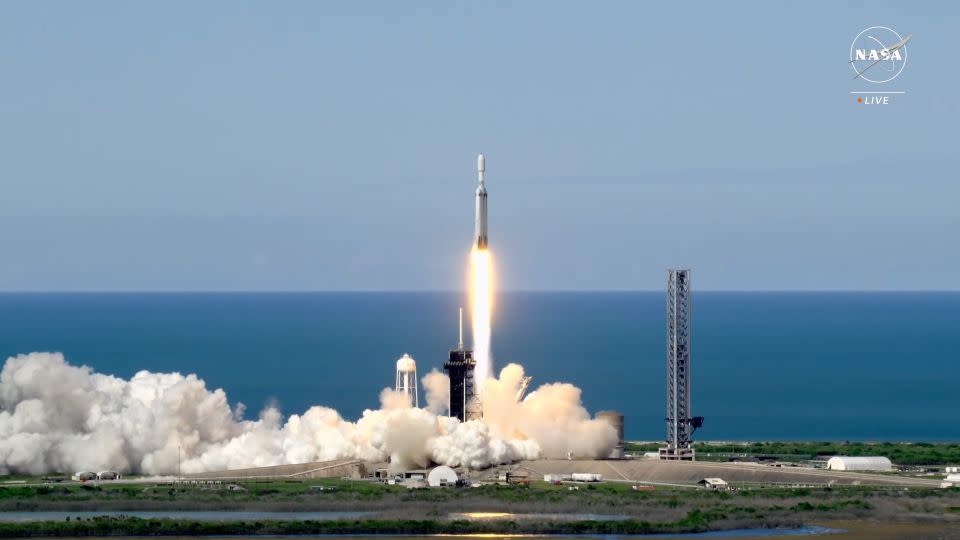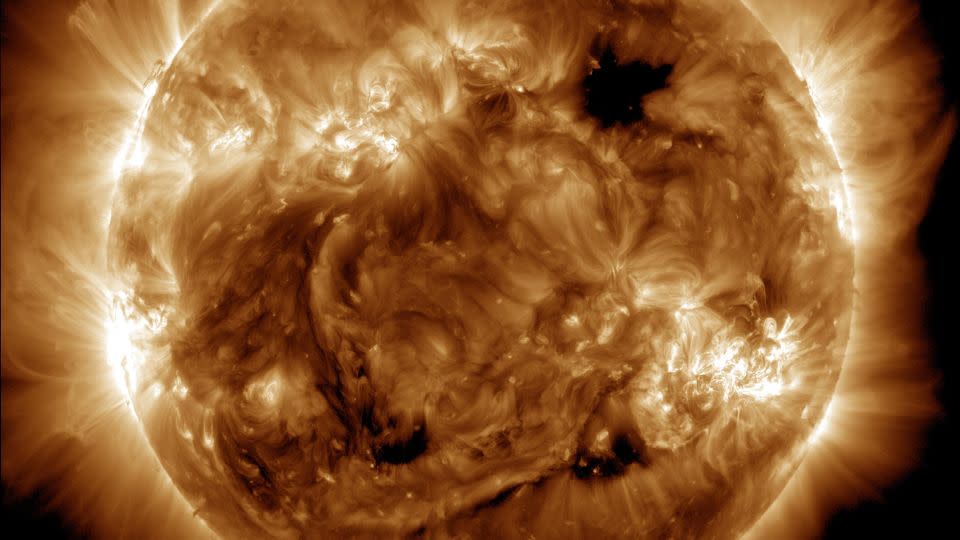Sign up for CNN’s Wonder Theory science newsletter. Explore the universe with news about fascinating discoveries, scientific breakthroughs and more.
Meteorologists will soon be able to see real-time mapping of Earth’s lightning activity and keep an eye on solar storms triggered by the Sun, thanks to a new weather satellite.
Together, NASA and the National Oceanic and Atmospheric Administration launched GOES-U, or the Geostationary Operational Environmental Satellite U mission, on Tuesday.
The weather satellite lifted off aboard a SpaceX Falcon Heavy rocket from the Kennedy Space Center in Florida at 5:26 p.m. ET. The launch was broadcast live on NASA website. Weather conditions in Florida were 60% favorable for a launch early in the launch window.
GOES-U is the fourth and final satellite in the R Series of Geostationary Operational Environmental Satellites, “the most sophisticated meteorological observation and environmental monitoring system in the Western Hemisphere,” according to NOAA.
“The GOES-R series of satellites is a game-changer for us,” said Ken Graham, director of NOAA’s National Weather Service, during a press conference Monday. “Since the first release of the series in 2016, the latest generation of GOES has enabled new and improved predictions and warning services to help save lives and protect property.”

Once GOES-U reaches a geostationary orbit, or a circular orbit above Earth’s equator, the satellite will be renamed GOES-19, or GOES East. The satellite will replace VAI-16, the former GOES East satellite launched in 2016, and works in conjunction with GOES-18, also called GOES West. Meanwhile, the GOES-16 satellite will essentially become an in-orbit backup for the system should one of the satellites crash.
Together, the GOES-18 and GOES-19 satellites will collect atmospheric, solar, climate and ocean data and cover more than half the globe, from the west coast of Africa to New Zealand.
What sets GOES-U apart from other satellites is that it carries a new capability to monitor space weather.
Tracking solar activity
As the sun approaches solar maximum — the peak of its 11-year cycle, expected this year — becomes more active. Researchers have observed increasingly intense solar flares and coronal mass ejections erupting from the Sun’s surface.
Coronal mass ejections are large clouds of ionized gas called plasma and magnetic fields that are released from the Sun’s outer atmosphere.
When these explosions are aimed at Earth, they can cause geomagnetic storms or large disturbances in Earth’s magnetic field. With these events, there is always the possibility that communications, the electrical network, navigation and radio and satellite operations will be affected.


The most intense solar storm to hit Earth in 20 years occurred on May 10, but fortunately only made the dawns shine about states that never see the Northern Lights.
Increased solar activity causes auroras that dance around Earth’s poles, known as the northern lights, or aurora borealis, and the southern lights, or aurora australis. When energized particles from coronal mass ejections hit Earth’s magnetic field, they interact with gases in the atmosphere to create different colored lights in the sky.
GOES-U carries several instruments that will improve the detection of space weather hazards, including the Compact Coronagraph-1 that can detect solar flares and coronal mass ejections, as well as characterize the size, speed, density and direction of these solar storms.
The coronagraph will provide continuous observations of the solar corona, or the hot outer layer of the Sun’s atmosphere, which is where space weather events originate, said Elsayed Talaat, director of NOAA’s Office of Space Weather Observations.
The instrument’s capabilities will allow NOAA’s Space Weather Prediction Center to issue warnings and observe one to four days in advance and “mark a new chapter in space weather observations,” Talaat said.
The Compact Coronagraph-1 is the world’s first operational satellite coronagraph to better monitor the sun, said Steve Volz, assistant administrator of NOAA’s Information and Satellite Service.
“This new instrument will provide images of the solar corona to our meteorologists at the Space Weather Prediction Center in 30 minutes, compared to the previous time it took, about eight hours,” Graham said. “Geomagnetic storms can impact our infrastructure here on Earth, putting our electrical grid, communications, navigation systems, aviation and space assets at risk. Having better and faster observation will help us better alert our infrastructure providers and potential dangers so they can take action.”
Lightning strikes in real time
From orbit, GOES-U will monitor weather, climate and environmental risks across North, Central and South America, the Caribbean and the Atlantic Ocean to the west coast of Africa.
From its unique vantage point, GOES-U will be able to detect tropical storms, send alerts to meteorologists as storms form in the Atlantic Ocean, and provide near real-time tracking and monitoring.
The satellite carries a suite of scientific instruments, including imaging and mapping technology, that will allow it to capture valuable hurricane data, including top-level wind speeds, specific features about the hurricane’s eye, and lightning activity, all of which can help meteorologists to better understand potential risks.
GOES-U will carry the first operational lightning mapper flying in geostationary orbit. As storms develop, they tend to experience spikes in lightning activity. Understanding how storms develop and intensify can help meteorologists better predict whether storms will be capable of causing flash flooding, producing hail, damaging winds or spawning tornadoes.
The lightning mapper will take photos of Earth at a rate of 500 times per second to track lightning like never before, Sullivan said.
GOES-U’s main camera can zoom in to track hazardous weather and environmental conditions every 30 seconds, a capability that allows for better warning systems, said Pam Sullivan, director of NOAA’s GOES-R program.
Meteorologists can also use GOES-U instruments to identify wildfire risks, including hot spots, intensity, smoke production and air quality impacts, and even data that can help trackers predict the movement of wildfires. . The satellite can also use its lightning mapper to determine which lightning strikes are most likely to spark wildfires.
Other environmental hazards that GOES-U can track include real-time images of fog and low clouds that could impact air and sea travel, as well as detecting volcanic eruptions and ash and sulfur dioxide spewed by volcanoes. GOES-U will also be able to monitor atmospheric river eventsor large sections of the Earth’s atmosphere that transport moisture from the equator to the poles, which are capable of causing floods and landslides.
In addition to early warning about hurricane formation, GOES-U can also collect climate data in Earth’s oceans, such as signals from marine heat waves and sea surface temperatures, which impact the marine food web and can lead to mass coral bleaching events.
For more news and newsletters from CNN, create an account at CNN.com



/cdn.vox-cdn.com/uploads/chorus_asset/file/25522359/wapo_climate_answers.png?w=300&resize=300,300&ssl=1)
































